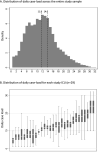Intensivist physician-to-patient ratios and mortality in the intensive care unit
- PMID: 37133740
- PMCID: PMC10155655
- DOI: 10.1007/s00134-023-07066-z
Intensivist physician-to-patient ratios and mortality in the intensive care unit
Abstract
Purpose: A high daily census may hinder the ability of physicians to deliver quality care in the intensive care unit (ICU). We sought to determine the relationship between intensivist-to-patient ratios and mortality among ICU patients.
Methods: We performed a retrospective cohort study of intensivist-to-patient ratios in 29 ICUs in 10 hospitals in the United States from 2018 to 2020. We used meta-data from progress notes in the electronic health record to determine an intensivist-specific caseload for each ICU day. We then fit a multivariable proportional hazards model with time-varying covariates to estimate the relationship between the daily intensivist-to-patient ratio and ICU mortality at 28 days.
Results: The final analysis included 51,656 patients, 210,698 patient days, and 248 intensivist physicians. The average caseload per day was 11.8 (standard deviation: 5.7). There was no association between the intensivist-to-patient ratio and mortality (hazard ratio for each additional patient: 0.987, 95% confidence interval: 0.968-1.007, p = 0.2). This relationship persisted when we defined the ratio as caseload over the sample-wide average (hazard ratio: 0.907, 95% confidence interval: 0.763-1.077, p = 0.26) and cumulative days with a caseload over the sample-wide average (hazard ratio: 0.991, 95% confidence interval: 0.966-1.018, p = 0.52). The relationship was not modified by the presence of physicians-in-training, nurse practitioners, and physician assistants (p value for interaction term: 0.14).
Conclusions: Mortality for ICU patients appears resistant to high intensivist caseloads. These results may not generalize to ICUs organized differently than those in this sample, such as ICUs outside the United States.
Keywords: Critical care; Intensive care units; Physicians; Workforce; Workload.
© 2023. Springer-Verlag GmbH Germany, part of Springer Nature.
Conflict of interest statement
The authors have no financial conflicts of interest to disclose.
Figures



Similar articles
-
The Association Between Daytime Intensivist Physician Staffing and Mortality in the Context of Other ICU Organizational Practices: A Multicenter Cohort Study.Crit Care Med. 2015 Nov;43(11):2275-82. doi: 10.1097/CCM.0000000000001259. Crit Care Med. 2015. PMID: 26308426 Free PMC article.
-
Association of Intensive Care Unit Patient-to-Intensivist Ratios With Hospital Mortality.JAMA Intern Med. 2017 Mar 1;177(3):388-396. doi: 10.1001/jamainternmed.2016.8457. JAMA Intern Med. 2017. PMID: 28118657
-
Comparing mortality among adult, general intensive care units in England with varying intensivist cover patterns: a retrospective cohort study.Crit Care. 2014 Aug 14;18(4):491. doi: 10.1186/s13054-014-0491-3. Crit Care. 2014. PMID: 25123141 Free PMC article.
-
Potential reduction in mortality rates using an intensivist model to manage intensive care units.Eff Clin Pract. 2000 Nov-Dec;3(6):284-9. Eff Clin Pract. 2000. PMID: 11151525 Review.
-
Intensivist/patient ratios in closed ICUs: a statement from the Society of Critical Care Medicine Taskforce on ICU Staffing.Crit Care Med. 2013 Feb;41(2):638-45. doi: 10.1097/CCM.0b013e3182741478. Crit Care Med. 2013. PMID: 23263586
Cited by
-
Formal guidelines from an expert panel: intensive care unit medical staffing, organisation and working hours to improve quality of life at work in France.Ann Intensive Care. 2025 Jan 20;15(1):15. doi: 10.1186/s13613-025-01432-4. Ann Intensive Care. 2025. PMID: 39833429 Free PMC article.
-
Measures and Impact of Caseload Surge During the COVID-19 Pandemic: A Systematic Review.Crit Care Med. 2024 Jul 1;52(7):1097-1112. doi: 10.1097/CCM.0000000000006263. Epub 2024 Mar 22. Crit Care Med. 2024. PMID: 38517234 Free PMC article.
-
Impact of institutional case volume on intensive care unit mortality.Acute Crit Care. 2023 May;38(2):151-159. doi: 10.4266/acc.2023.00689. Epub 2023 May 31. Acute Crit Care. 2023. PMID: 37313661 Free PMC article.
-
Variation in Corticosteroid Prescribing Practices for Patients With Septic Shock.Crit Care Explor. 2025 Feb 21;7(3):e1196. doi: 10.1097/CCE.0000000000001196. eCollection 2025 Mar 1. Crit Care Explor. 2025. PMID: 39982133 Free PMC article.
-
Infection Prevention and Control Strategies According to the Type of Multidrug-Resistant Bacteria and Candida auris in Intensive Care Units: A Pragmatic Resume including Pathogens R0 and a Cost-Effectiveness Analysis.Antibiotics (Basel). 2024 Aug 22;13(8):789. doi: 10.3390/antibiotics13080789. Antibiotics (Basel). 2024. PMID: 39200090 Free PMC article. Review.
References
MeSH terms
Grants and funding
LinkOut - more resources
Full Text Sources

